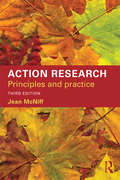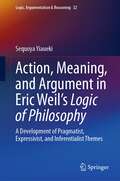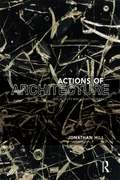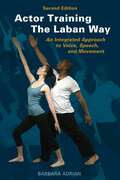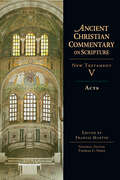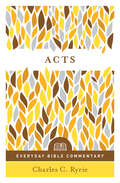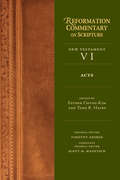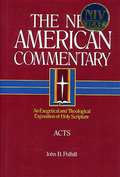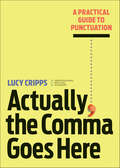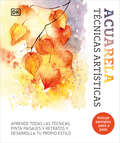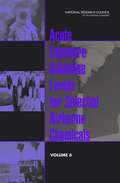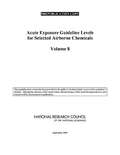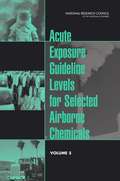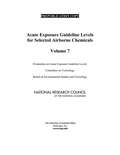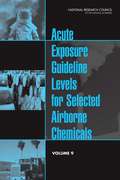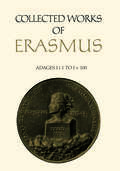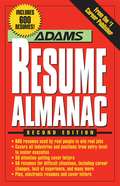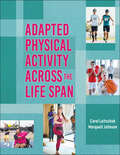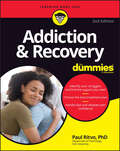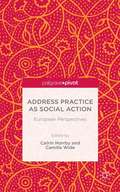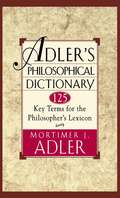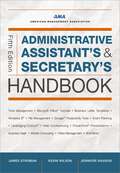- Table View
- List View
Action Research: Principles and practice
by Jean McNiffSince its first publication, Action Research: Principles and Practice has become a key text in its field. This new updated edition clearly describes and explains the practices of action research and its underlying values, and introduces important new ideas, including: all professionals should be reflective practitioners; they should produce their personal theories of practice to show how they are holding themselves accountable for their educational influences in learning; the stories they produce become a new people’s history of action research, with potential for influencing new futures. This new edition has expanded in scope, to contribute to diverse fields including professional development across the sectors and the disciplines. It considers the current field, including its problems as well as its considerable hopes and prospects for new thinking and practices. Now fully updated, this book contains: A wealth of case-study material New chapters on the educational significance of action research An overview of methodological and ethical discussion The book is a valuable addition to the literature on research methods in education and nursing and healthcare, and professional education, and contributes to contemporary debates about the generation and dissemination of knowledge and its potential influence for wider social and environmental contexts. Practitioners across the professions who are planning action research in their own work settings will find this book a helpful introduction to the subject while those studying on higher degree courses will find it an indispensable resource.
Action, Meaning, and Argument in Eric Weil's Logic of Philosophy: A Development of Pragmatist, Expressivist, and Inferentialist Themes (Logic, Argumentation & Reasoning #32)
by Sequoya YiauekiThis volume investigates Eric Weil’s innovative conceptualization of the place of violence in the philosophical tradition with a focus on violence’s relationship to language and to discourse. Weil presents violence as the central philosophical problem. According to this reading, the western philosophical tradition commonly conceptualizes violence as an expression of error or as a consequence of the weakness of will. However, by doing so, it misses something essential about the role that violence plays in our conceptual development as well as the place violence holds in our discursive practices.The author draws comparisons between Weil’s work and that of Robert Brandom. Brandom’s inferentialism creates a sophisticated program at the junction of pragmatics and semantics, philosophy of language, logic, and philosophy of mind. The monograph builds on these insights in order to show how an inferentialist reading of Eric Weil is fruitful for both Weilian studies and for inferentialism. This volume will notably be of interest to scholars in philosophy, argumentation theory, and communication studies.
Actions of Architecture: Architects and Creative Users
by Jonathan HillDrawing on the work of a wide range of architects, artists and writers, this book considers the relations between the architect and the user, which it compares to the relations between the artist and viewer and the author and reader. The book's thesis is informed by the text 'The Death of the Author', in which Roland Barthes argues for a writer aware of the creativity of the reader. Actions of Architecture begins with a critique of strategies that define the user as passive and predictable, such as contemplation and functionalism. Subsequently it considers how an awareness of user creativity informs architecture, architects and concepts of authorship in architectural design. Identifying strategies that recognize user creativity, such as appropriation, collaboration, disjunction, DIY, montage, polyvalence and uselessness, Actions of Architecture states that the creative user should be the central concern of architectural design.
Active Listening: Improve Your Ability to Listen and Lead, Second Edition
by Center for Creative LeadershipListening well is an essential component of good leadership. You can become a more effective listener and leader by learning the skills of active listening. Working relationships become more solid, based on trust, respect, and honesty. Active listening is not an optional component of leadership; it is not a nicety to be used to make others feel good. It is, in fact, a critical component of the tasks facing today's leaders. In this new edition, we've added tips and advice dealing with virtual active listening and incorporated up-to-date research from both inside and outside CCL to make sure you can best meet the leadership challenges you face in today's world.
Actor Training the Laban Way (Second Edition): An Integrated Approach to Voice, Speech, and Movement
by Barbara AdrianThe Groundbreaking Actor Training Guide, Enhanced with New Videos and Expert Advice from Acting Professionals Actors, teachers, and students of performing arts: sharpen your skills and release your potential with Actor Training the Laban Way, a groundbreaking approach to physical and vocal movement. Utilizing theories of preeminent movement theorist Rudolf Laban, acting teacher and performer Barbara Adrian integrates voice, speech, and movement training with illustrated individual and group exercises that include: Breath Support Building Dynamic Alignment Expanding Vocal Tone and Range Articulation and Rhythmic Exploration Enhancing Strength and Stamina Improving Balance and Flexibility Developing a Relationship to the Environs Revealing Your Emotional State through Physical and Vocal Action This second edition also includes an all-new chapter of advice from acting professionals on how they deploy these exercises and techniques in their acting preparation, practice, and performance. New appendices offer readers links to video supplements as well as exercises in IPA.Actor Training the Laban Way will make any performer more impulsive, imaginative, and expressive.
Acts (Ancient Christian Commentary on Scripture #5)
by Thomas C. Oden Francis Martin Evan SmithHomilies on the Acts of the Apostles,Commentary on the Acts of the ApostlesCatena in Acta SS. Apostolorum.
Acts (Everyday Bible Commentary)
by Charles C. RyrieThe book of Acts is a thrilling account of the early church discovering what it means to be Christian. Through the power of the Holy Spirit, they lived out a triumphant faith in the face of opposition and persecution, established order for the growing movement, and took the gospel to the ends of the earth. It&’s an exhilarating story, and there are even more treasures lying underneath the surface. Encounter the beautiful depth of Acts through enlightening verse-by-verse commentary from Charles Ryrie that&’s both straightforward and insightful. You&’ll gain:Important historical backgroundInsights from the original language Help with the difficult passages And more!You don&’t have to go to seminary to encounter God in exciting, new ways through His Word. Discover how much more enjoyable your personal study will be with understandable, quality Bible commentary for everyday life.
Acts (Everyday Bible Commentary)
by Charles C. RyrieThe book of Acts is a thrilling account of the early church discovering what it means to be Christian. Through the power of the Holy Spirit, they lived out a triumphant faith in the face of opposition and persecution, established order for the growing movement, and took the gospel to the ends of the earth. It&’s an exhilarating story, and there are even more treasures lying underneath the surface. Encounter the beautiful depth of Acts through enlightening verse-by-verse commentary from Charles Ryrie that&’s both straightforward and insightful. You&’ll gain:Important historical backgroundInsights from the original language Help with the difficult passages And more!You don&’t have to go to seminary to encounter God in exciting, new ways through His Word. Discover how much more enjoyable your personal study will be with understandable, quality Bible commentary for everyday life.
Acts (Reformation Commentary on Scripture Series #6)
by Esther Chung-Kim Todd R. HainsPreaching'sReformation Commentary on Scripture,
Acts (The New American Commentary, v. #26)
by John B. PolhillTHE NEW AMERICAN COMMENTARY is for the minister or Bible student who wants to understand and expound the Scriptures. Notable features include: * commentary based on THE NEW INTERNATIONAL VERSION; * the NIV text printed in the body of the commentary; * sound scholarly methodology that reflects capable research in the original languages; * interpretation that emphasizes the theological unity of each book and of Scripture as a whole; * readable and applicable exposition.
Actually, the Comma Goes Here: A Practical Guide to Punctuation
by Lucy CrippsFun, funny, and factual—the most complete guide to punctuation for beginners and experts alike. Period.No one's ever said that learning punctuation is fun—until now. Actually, The Comma Goes Here takes a lighthearted yet highly informative approach to ensuring you never misplace a comma again.Whether it's semicolons or exclamation points, this primer has you covered with chapters that dive deep into the correct use for each and every piece of punctuation. You'll find plenty of fun (and funny) examples of proper writing while also learning how punctuation has changed throughout history.Actually, The Comma Goes Here includes:A complete crash course—Keep things simple with chapters that progress from the most basic punctuation (like periods) to more advanced or uncommon punctuation (like brackets).Memorable advice—Never mix your clauses up again thanks to easy-to-remember breakdowns, handy mnemonics, and entertaining sample sentences.Matters of style—Discover a quick reference chart that details the differences between the most common style guides, including the Chicago Manual of Style and Associated Press.Perfect your punctuation with the help of this comprehensive guidebook.
Acuarela (Artist's Watercolor Techniques): Técnicas artisticas
by DKKickstart your creativity and make a masterpiece with step-by-step workshops and advice from professional artists. Whether you’re just starting out with watercolor painting or want to expand your skills and raise your art to the next level, this book has all the inspiration and practical know-how you'll need.Starting from the basics, such as choosing the right brushes and practicing color mixes, the book tackles every conceivable watercolor technique - from applying a flat wash to experimenting with texture. Techniques and inspiration are then combined in a wide-ranging section on subject matter - from landscapes to botanical illustration, urban scenes, portraiture, and abstraction - which examines the practical considerations of each topic and showcases numerous different approaches to try, with tutorials on achieving particular effects.Here's what you'll find inside the pages of this guide:Includes over 80 detailed step-by-step workshops for pencil, charcoal, pen, and pastel techniques.A range of techniques suits beginners or more experienced artists.Techniques are approached with progression in mind so readers can learn the basics and move on to new creative challenges.Artist's Watercolour Techniques will help you tap into your creative potential and unlock new talents, whether you are a beginner or a seasoned artist. This is the ultimate watercolor painting course to help you take your sketches to a higher level. Each technique and stylistic approach is demonstrated by a professional artist working on an original painting, photographed at different stages of development to give rare insights into the artistic process.---------------------------Pon en marcha tu creatividad y crea una obra maestra con ejercicios paso a paso y consejos de artistas profesionales.Tanto si estás comenzando a pintar con acuarela como si deseas mejorar tus habilidades y llevar tu arte al siguiente nivel, gracias a Acuarela Técnicas Artísticas podrás desarrollar tu talento y crecer como artista.Este completo libro de pintura aborda todo lo necesario para iniciarte en el arte de la acuarela: desde lo básico como elegir los pinceles adecuados y mezclar colores, hasta técnicas de acuarela populares y avanzadas como la pincelada plana, el mojado en seco o cómo experimentar con texturas.En el interior de esta completa guía paso a paso para pintar acuarela encontrarás:Más de 80 ejercicios para aprender los principios de composición y dominar diferentes técnicas, como el lavado en plano.Instrucciones detalladas e imágenes con explicaciones paso a paso.Amplia selección de temas: desde paisajes, escenas urbanas, retratos, dibujos abstractos y mucho más.Consejos de artistas profesionales y proyectos inspiradores para que pongas a prueba lo aprendido desde casa.Acuarela: técnicas artísticas es el mejor libro para aprender a pintar. Te ayudará a exprimir tu potencial creativo y desbloquear nuevos talentos, ya seas un artista principiante o todo un experto. Este es el curso de acuarela definitivo para ayudarte a que tus bocetos cobren vida.¡Domina todas las técnicas de la pintura con acuarela y crece como artista!
Acute Exposure Guideline Levels for Selected Airborne Chemicals: VOLUME 6
by National Research Council of the National AcademiesThis book is the sixth volume in the series Acute Exposure Guideline Levels for Selected Airborne Chemicals, and includes AEGLs for chemicals such as ammonia, nickel carbonyl and phosphine, among others.<P><P> At the request of the Department of Defense, the National Research Council has reviewed the relevant scientific literature compiled by an expert panel and established Acute Exposure Guideline Levels (AEGLs) for 12 new chemicals. AEGLs represent exposure levels below which adverse health effects are not likely to occur and are useful in responding to emergencies such as accidental or intentional chemical releases in the community, the workplace, transportation, the military, and for the remediation of contaminated sites. Three AEGLs are approved for each chemical, representing exposure levels that result in: 1) notable but reversible discomfort; 2) long-lasting health effects; and 3) life-threatening health impacts.
Acute Exposure Guideline Levels for Selected Airborne Chemicals: VOLUME 4
by National Research Council of the National AcademiesThis book is the eighth volume in the series Acute Exposure Guideline Levels for Selected Airborne Chemicals, and reviews AEGLs for acrolein, carbon monoxide, 1,2-dichloroethene, ethylenimine, fluorine, hydrazine, peracetic acid, propylenimine, and sulfur dioxide for scientific accuracy, completeness, and consistency with the NRC guideline reports.
Acute Exposure Guideline Levels for Selected Airborne Chemicals: VOLUME 5
by National Research Council of the National AcademiesIn 1993, the National Research Council';s Committee on Toxicology developed criteria and methods for EPA and the Agency for Toxic Substances and Disease Registry (ATSDR) to develop community emergency exposure levels for extremely hazardous substances for the general population. <P><P>A few years later, the National Advisory Committee for Acute Exposure Guideline Levels for Hazardous Substances (NAC)--composed of members of EPA, DOD, other federal and state agencies, industry, academia, and other organizations--was established to identify, review, and interpret toxicologic and other scientific data to develop acute exposure guidelines (AEGLs) for high-priority, acutely toxic chemicals. Three levels--AEGL-1, AEGL-2, and AEGL-3 are developed for each of five exposure periods (10 min, 30 min, 1 hr, 4 hr, and 8 hr) and are distinguished by varying degrees of severity of toxic effects. This current report reviews the NAC reports for their scientific validity, completeness, and consistency with the NRC guideline reports developed in 1993 and 2001. This report is the fifth volume in the series and covers AEGLs for chlorine dioxide, chlorine trifluoride, cyclohexylamine, ethylenediamine, hydrofluoroether-7100, and tetranitromethane. It concludes that the AEGLs developed by NAC are scientifically valid and consistent with the NRC guideline reports. AEGLs are needed for a wide range of planning, response, and prevention applications. These values provide data critical to evacuation decisions and discussions between community leaders and industries as they seek ways to minimize the health impact should the chemical release occur. Some of the finalized AEGLs have been officially adopted by the Department of the Army, FEMA, and the Department of Transportation as the official levels for use by those agencies.
Acute Exposure Guideline Levels for Selected Airborne Chemicals: Volume 7
by National Research Council of the National AcademiesThis book is the seventh volume in the series Acute Exposure Guideline Levels for Selected Airborne Chemicals, and includes AEGLs for acetone cyanohydrin, carbon disulfide, monochloroacetic acid, and phenol. <P><P>At the request of the Department of Defense, the National Research Council has reviewed the relevant scientific literature compiled by an expert panel and established Acute Exposure Guideline Levels (AEGLs) for 12 new chemicals. AEGLs represent exposure levels below which adverse health effects are not likely to occur and are useful in responding to emergencies such as accidental or intentional chemical releases in the community, the workplace, transportation, the military, and for the remediation of contaminated sites. Three AEGLs are approved for each chemical, representing exposure levels that result in: 1) notable but reversible discomfort; 2) long-lasting health effects; and 3) life-threatening health impacts.
Acute Exposure Guideline Levels for Selected Airborne Chemicals: Volume 8
by National Research Council of the National AcademiesThis book is the eighth volume in the series Acute Exposure Guideline Levels for Selected Airborne Chemicals, and reviews AEGLs for acrolein, carbon monoxide, 1,2-dichloroethene, ethylenimine, fluorine, hydrazine, peracetic acid, propylenimine, and sulfur dioxide for scientific accuracy, completeness, and consistency with the NRC guideline reports.
Acute Exposure Guideline Levels for Selected Airborne Chemicals: Volume 9
by National Research Council of the National AcademiesThis book is the ninth volume in the series Acute Exposure Guideline Levels for Selected Airborne Chemicals, and reviews AEGLs for bromine, ethylene oxide, furan, hydrogen sulfide, propylene oxide, and xylenes.
Adages: Ii1 to Iv100
by Desiderius Erasmus Margaret Mann Phillips R.A.B. MynorsErasmus' Adagia has been called 'one of the world's biggest bedside books,' and certainly the more than 4000 proverbs and maxims gathered and commented on by Erasmus, sometimes in a few lines and sometimes in full-scale essays, have great appeal for both scholar and educated layman. The aim of the Adages was to recapture, in this handy portmanteau form, the outlook and way of life of the classical world through its customs, legends, and social institutions, and to put within reach of a modern public the accumulated wisdom of the past. Each adage is traced in the works of as many authors as Erasmus had to hand; always an authority is given (usually several) and often a close reference providing chapter and verse. The commentaries in the Adages give a forthright and often eloquent expression of Erasmus' opinions on the world of his day, dovetailing with his satirical works on the one hand and his popular evangelical writings on the other. Many, if not most, of the proverbs cited by Erasmus are still in our common stock of speech today. The Collected Works of Erasmus is providing the first complete translation of Erasmus' Adagia. This volume contains the initial 300 adages with notes that identify the classical sources and indicate how Erasmus' reading and thinking developed over the quarter-century spanned by the eight revisions of the original work. Volume 31 of the Collected Works of Erasmus series.
Adams Resume Almanac
by Richard J WallaceA revised edition of the most comprehensive resume guide on the market! A must for the successful job search, The Adams Resume Almanac, 2nd Edition contains everything a candidate needs to know in order to craft a compelling, job-winning resume. Whether a first-time job hunter starting with a blank page, or a seasoned professional with a long story to tell, the candidate will find 600 examples of resumes appropriate to every situation.
Adapted Physical Activity Across the Life Span
by Carol Leitschuh Marquell JohnsonWhile there are plenty of texts out there on adapted physical activity, there are none like this one. <P><P> That’s because Adapted Physical Activity Across the Life Span takes a unique interdisciplinary approach from education, sports, and the health sciences. It incorporates adapted physical activity’s long history of DEI (diversity, equity, and inclusion) and the importance of SEL (social-emotional learning) to prepare pre-professionals and professionals for service delivery in today’s world.
Addiction & Recovery For Dummies
by Paul RitvoNo matter what your road to recovery looks like, Dummies is on your side Addiction and Recovery For Dummies gives you the tools you need to identify and face addiction in yourself or a loved one, while working towards a healthy and realistic approach to recovery. This book offers a compassionate, unbiased, and non-judgmental guide to evaluating and overcoming addiction. You’ll learn to identify the range of addiction levels, the various types (including substance and non-substance), and the possible causes of addiction. An expert author guides you through the range of addiction treatment philosophies and approaches, including twelve-step programs, other in- and outpatient programs, and teen treatments. We’ll also look at common recovery roadblocks, so you’re prepared to overcome whatever hurdles your recovery process brings. Medications, therapeutic communities, self-help groups, long-term recovery strategies—it’s all in here. Learn the signs of addiction and identify the most appropriate treatments Gain advice on offering help to friends or family members struggling with addiction Discover available recovery supports, including groups and medications Understand the media and cultural factors that encourage addiction, and how to avoid themUpdated with the latest treatment options, Addiction & Recovery For Dummies is a valuable resource for those on a recovery journey, and a support guide for the 45 million people who are directly impacted by addiction.
Address Practice As Social Action: European Perspectives
by Catrin Norrby Camilla WideHow we address one another says a great deal about our social relationships and which groups in society we belong to. This edited volume examines address choices in a range of everyday interactions taking place in Dutch, Finnish, Flemish, French, German, Italian and the two national varieties of Swedish, Finland Swedish and Sweden Swedish.
Adler's Philosophical Dictionary
by Mortimer J. AdlerThe terms and concepts that have simulated thinkers from Aristotle onward come to life in the latest work by the man TIME magazine has called "America's philosopher for everyman". Is the human soul immortal? What does it mean to know something? What is the nature of erotic love? Adler examines these questions as well as many others with his trademark clarity, rigor, and common sense.
Administrative Assistant's and Secretary's Handbook
by James Stroman Kevin Wilson Jennifer WausonThe expectations and duties of the modern-day administrative assistant are higher and more stressful than ever before. The Administrative Assistant&’s and Secretary&’s Handbook will help professionals everywhere come out on top.From managing the phones, coordinating meetings, and preparing presentations to planning events, crafting clear business communications, and deciphering legal documents, administrative assistants need to be everything to everyone, all the time--and all with a smile. They spend all day helping others, but who is going to help them?For office professionals seeking to improve their performance and enhance their value to employers, this handbook is the definitive source of help for these true jack-of-all-trades.In The Administrative Assistant&’s and Secretary&’s Handbook, you will find information on topics such as:Creating graphics, charts, and presentations;Microsoft Word, Excel, Outlook, and Publisher;Web conferencing;Electronic and paper filing systems;Recordkeeping;Meeting planning and management;Business math and much more!Extensively updated with new information on Windows 8, Microsoft Office 2013, Apple OS, mobile computing, computer & software troubleshooting, data security, Google Calendar, Google Drive, Google Docs, and Microsoft Web Applications, this bestselling guide will help these unsung heroes shine in the eyes of all their coworkers.
